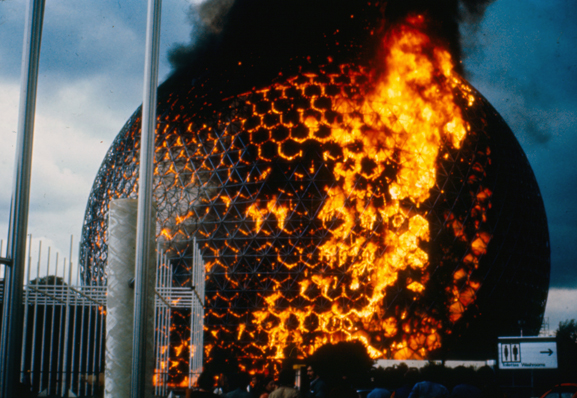
20 May 1976, Montreal—Final preparations for the Summer Olympics were underway when the United States pavilion, a twenty-storey geodesic dome built by Buckminster Fuller for Expo 67, caught fire during routine repairs. The entire acrylic shell was gone within half an hour, the metal structure reduced to one more ruin among the abandoned national pavilions that populated the island. Nine years prior, the site had served as a global playground, virtually insuring the city’s bid to host the 1976 Summer Games.

A series of drawings demonstrate the lineage of events, ranging from the failure of Buckminster Fuller’s first full-size geodesic structure in 1948 at Black Mountain College; through the use of Expo 67’s futuristic ruins as the backdrop for a sci-fi television show; and onward to the 2004 demise of the Montreal Expos, the baseball team that played in the infamous Stade Olympique, built for the 1976 Olympics but never completed.

With the demise of Buckminster Fuller’s pavilion serving as the central episode, the viewer is invited to enter Spirit of 76, a 2m-tall geodesic dome. The white dome seems the quiet and hopeful emblem of Utopian architecture, only to reveal a surface marred by a projected image of the pavilion engulfed in flames. Inside hangs a mobile constructed of celestial symbols physically extruded from various national flags, inspired by the protestors who removed the stars from the American flag during President Lyndon Johnson’s visit to Expo 67, an episode recounted in an adjacent drawing.


Abandoned sports stadiums serve as the point of departure for a series of drawings, discrete objects and sculptures picturing Houston’s Astrodome, built as the “Eighth Wonder of the World” only to be rendered obsolete by 1999—and to then provide emergency shelter in the wake of Hurricane Katrina. Proposals for a Flexible Architecture extends this hybrid function by transforming models of the Astrodome and other stadiums into mosques, making use of an Islamic clause that allows existing structures to function as religious architecture. Point Conversion transforms an Astroturf playing field into a prayer rug.









20 May 1976, Montreal—Final preparations for the Summer Olympics were underway when the United States pavilion, a twenty-storey geodesic dome built by Buckminster Fuller for Expo 67, caught fire during routine repairs. The entire acrylic shell was gone within half an hour, the metal structure reduced to one more ruin among the abandoned national pavilions that populated the island. Nine years prior, the site had served as a global playground, virtually insuring the city’s bid to host the 1976 Summer Games.
A series of drawings demonstrate the lineage of events, ranging from the failure of Buckminster Fuller’s first full-size geodesic structure in 1948 at Black Mountain College; through the use of Expo 67’s futuristic ruins as the backdrop for a sci-fi television show; and onward to the 2004 demise of the Montreal Expos, the baseball team that played in the infamous Stade Olympique, built for the 1976 Olympics but never completed.
With the demise of Buckminster Fuller’s pavilion serving as the central episode, the viewer is invited to enter Spirit of 76, a 2m-tall geodesic dome. The white dome seems the quiet and hopeful emblem of Utopian architecture, only to reveal a surface marred by a projected image of the pavilion engulfed in flames. Inside hangs a mobile constructed of celestial symbols physically extruded from various national flags, inspired by the protestors who removed the stars from the American flag during President Lyndon Johnson’s visit to Expo 67, an episode recounted in an adjacent drawing.
Abandoned sports stadiums serve as the point of departure for a series of drawings, discrete objects and sculptures picturing Houston’s Astrodome, built as the “Eighth Wonder of the World” only to be rendered obsolete by 1999—and to then provide emergency shelter in the wake of Hurricane Katrina. Proposals for a Flexible Architecture extends this hybrid function by transforming models of the Astrodome and other stadiums into mosques, making use of an Islamic clause that allows existing structures to function as religious architecture. Point Conversion transforms an Astroturf playing field into a prayer rug.